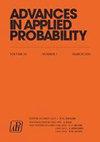密集随机块模型的模型选择
IF 1.2
4区 数学
Q3 STATISTICS & PROBABILITY
引用次数: 1
摘要
摘要本文研究了稠密图渐近中随机块模型的Rissanen最小描述长度(MDL)估计问题。我们专注于模型规范的问题,即块数量的识别。真实分区的细化总是减少与边缘放置相对应的代码部分,因此指定模型的代码部分的相应增加应该使该增益超重,以便在真实分区处产生最小值。这些影响之间的平衡是微妙的。我们证明了MDL原理在相对块大小有界于零的模型之间识别真正的分区。将结果推广到具有泊松分布边权的模型。本文章由计算机程序翻译,如有差异,请以英文原文为准。
On model selection for dense stochastic block models
Abstract This paper studies estimation of stochastic block models with Rissanen’s minimum description length (MDL) principle in the dense graph asymptotics. We focus on the problem of model specification, i.e., identification of the number of blocks. Refinements of the true partition always decrease the code part corresponding to the edge placement, and thus a respective increase of the code part specifying the model should overweight that gain in order to yield a minimum at the true partition. The balance between these effects turns out to be delicate. We show that the MDL principle identifies the true partition among models whose relative block sizes are bounded away from zero. The results are extended to models with Poisson-distributed edge weights.
求助全文
通过发布文献求助,成功后即可免费获取论文全文。
去求助
来源期刊

Advances in Applied Probability
数学-统计学与概率论
CiteScore
2.00
自引率
0.00%
发文量
64
审稿时长
6-12 weeks
期刊介绍:
The Advances in Applied Probability has been published by the Applied Probability Trust for over four decades, and is a companion publication to the Journal of Applied Probability. It contains mathematical and scientific papers of interest to applied probabilists, with emphasis on applications in a broad spectrum of disciplines, including the biosciences, operations research, telecommunications, computer science, engineering, epidemiology, financial mathematics, the physical and social sciences, and any field where stochastic modeling is used.
A submission to Applied Probability represents a submission that may, at the Editor-in-Chief’s discretion, appear in either the Journal of Applied Probability or the Advances in Applied Probability. Typically, shorter papers appear in the Journal, with longer contributions appearing in the Advances.
 求助内容:
求助内容: 应助结果提醒方式:
应助结果提醒方式:


